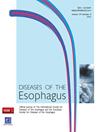810.机器人辅助糜烂栓塞术治疗伊沃-路易斯食管切除术后的腹腔糜烂渗漏
IF 2.3
3区 医学
Q3 GASTROENTEROLOGY & HEPATOLOGY
引用次数: 0
摘要
背景 高输出量糜烂性渗漏是食管切除术后的一种棘手并发症,具有很高的发病率甚至死亡率。最初的保守治疗通常建议使用肠外喂养,结果导致长时间住院和胸管置入时间延长。在此,我们介绍了一例 Ivor-Lewis 食管切除术后高输出糜烂性渗漏病例,我们将渗漏部位定位在糜烂膀胱,随后结合机器人、荧光和胶水栓塞进行了手术治疗。方法 一位 74 岁的男性因食管远端腺癌接受了机器人辅助微创 Ivor Lewis 食管切除术。术后,尽管进行了肠外喂养,但每天从胸部排出的乳糜液仍高达 700-1300cc 。脂肪碘淋巴管造影发现造影剂在糜烂宫颈处外渗,并对胸导管进行了正确的剪切。由于保守治疗无效,在术后第 14 天,患者在机器人辅助下对躯干区域进行了探查,并在结节内注射了吲哚菁绿。结果 这一创新手术发现了位于糜烂囊内侧的腹腔截尾内侧漏点。通过使用微导管进行经皮腔内栓塞和注射 Histoacryl® 实现了淋巴密封,结果渗漏突然消失,并在再次手术后第 5 天通过口服 MCT 饮食出院。结论 本病例展示了一种创新的多模式技术的可行性和有效性,该技术结合了机器人手术的灵巧性和荧光性,以及介入放射学栓塞技术的腹腔镜应用。由于存在静脉栓塞的风险,我们注意到该技术仅适用于胸导管中断的腹腔糜烂渗漏病例。https://www.dropbox.com/scl/fi/sktltdc1be41jfq4dk3lt/Video-Presentation-ISDE-2024-Robotic-Embolisation-Abdominal-Chyle-leakage-Def.mp4?rlkey=1wni1dpnjg4swiajcjdfa6isn&st=wx30jbi7&dl=0本文章由计算机程序翻译,如有差异,请以英文原文为准。
810. ROBOTIC ASSISTED CISTERNA CHYLI EMBOLIZATION FOR ABDOMINAL CHYLE LEAKAGE AFTER IVOR LEWIS ESOPHAGECTOMY
Background High output chyle leakage is a challenging complication following esophagectomy, carrying substantial morbidity and even mortality. Initial conservative management with parenteral feeding is commonly advised resulting in lengthy episodes of hospitalization and prolonged chest tube placement. Here, we present a case post Ivor-Lewis esophagectomy with high-output chyle leakage where we localized the leakage site to be at the cysterna chyli and subsequently treated it operatively combining robotics, fluorescence and embolization with glue. Methods A 74-year-old male underwent robotic-assisted minimally invasive Ivor Lewis esophagectomy for distal esophageal adenocarcinoma. Postoperatively, chylous fluid was drained from the chest up to 700-1300cc per day despite parenteral feeding. Lipiodol lymphangiography identified extravasation of contrast at the cysterna chyli and correct clipping of the thoracic duct. Due to failure of conservative management, on postoperative day 14, robotic-assisted exploration of the truncal region with intranodal injection of indocyanine green was performed. Results This innovative procedure revealed the leakage site medially of the coeliac trunc at the cysterna chyli. Lymphatic sealing was achieved via percutaneous endoluminal embolization using a microcatheter and Histoacryl® injections, resulting in an abrupt resolution of the leak and discharge with oral MCT diet on day 5 after reoperation. Conclusion This case demonstrated the feasibility and efficacy of an innovative multimodal technique combining the dexterity and fluorescence of robotic surgery with a laparoscopic application of an interventional radiology embolization technique. Because of the risk of venous emboli, we note that this technique should only be applied in cases of abdominal chyle leakage when the thoracic duct is interrupted. https://www.dropbox.com/scl/fi/sktltdc1be41jfq4dk3lt/Video-Presentation-ISDE-2024-Robotic-Embolisation-Abdominal-Chyle-leakage-Def.mp4?rlkey=1wni1dpnjg4swiajcjdfa6isn&st=wx30jbi7&dl=0
求助全文
通过发布文献求助,成功后即可免费获取论文全文。
去求助
来源期刊

Diseases of the Esophagus
医学-胃肠肝病学
CiteScore
5.30
自引率
7.70%
发文量
568
审稿时长
6 months
期刊介绍:
Diseases of the Esophagus covers all aspects of the esophagus - etiology, investigation and diagnosis, and both medical and surgical treatment.
 求助内容:
求助内容: 应助结果提醒方式:
应助结果提醒方式:


